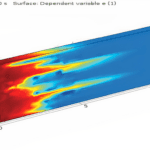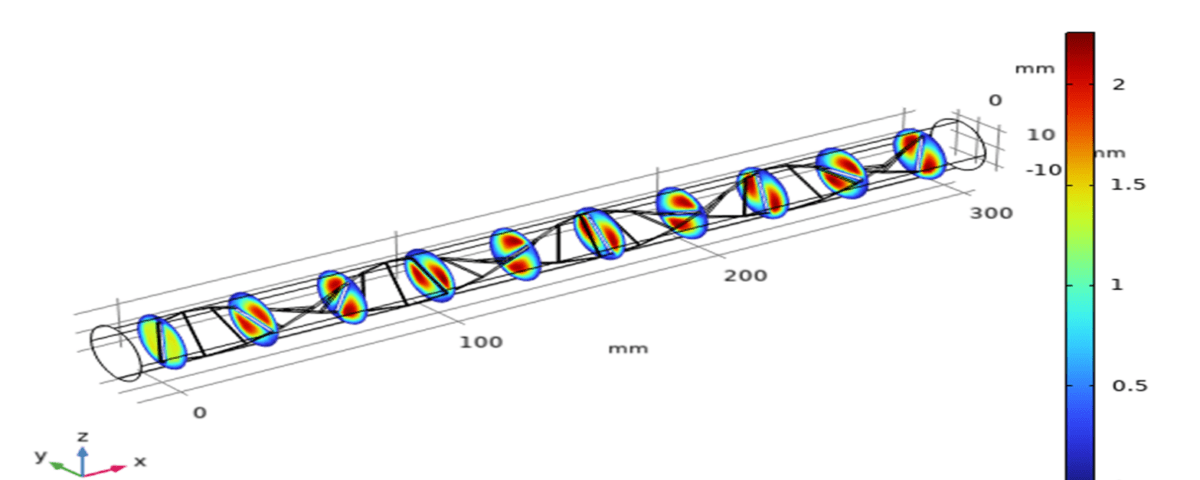Introduction
Heat transfer and efficiency play a vital role in enhancing the performance and reducing the operational costs of industrial processes in chemical engineering systems. With the growing demand for energy conservation and industrial process optimization, the development of innovative techniques for improving heat transfer has become an essential focus. Among these techniques, the use of active and passive methods in heat exchangers has garnered significant attention.
One of the most promising passive methods is the incorporation of twisted tape inserts. These inserts enhance heat transfer by generating vortex flows within the fluid, which increase mixing and reduce the thermal boundary layer. As a result, heat transfer rates are significantly improved. However, this technique also introduces additional pressure drops, necessitating precise analysis and economic evaluation.
The primary objective of this project is to investigate the effects of twisted tape inserts on heat transfer and fluid flow characteristics in pipes using Computational Fluid Dynamics (CFD) methods. By simulating fluid flow and heat transfer in the presence of twisted tapes, the study examines key parameters such as the Nusselt number and pressure drop.
Research Objectives
- Analyze the effect of twisted tape inserts on the Nusselt number and heat transfer coefficient: The Nusselt number, as a key indicator of thermal performance, is evaluated based on vortex flows induced by twisted tapes.
- Examine pressure drop variations due to twisted tape inserts: The increase in pressure drop caused by additional flow resistance is assessed, along with its impact on overall system efficiency.
- Evaluate fluid flow behavior across various Reynolds numbers: The flow behavior in different regimes, ranging from laminar to turbulent, is analyzed to provide a comprehensive understanding of the impact of twisted tapes.
- Study the geometric design of twisted tapes: The influence of twist ratio, twist angle, and other geometric parameters on the thermal and hydraulic performance of the system is investigated.
Simulation Methodology
Software and Modeling
This study employs COMSOL Multiphysics, a powerful simulation software renowned for its multi-physics analysis capabilities and flexibility in defining complex geometries and boundary conditions. The model includes a 3D pipe design with an inner diameter of 0.0266 meters and a length of 0.32 meters. A twisted tape with a twist ratio of 3.46 and a twist angle of 30 degrees is inserted within the pipe. The geometry is optimized to enhance fluid flow in the presence of the twisted tape and to maximize heat transfer.
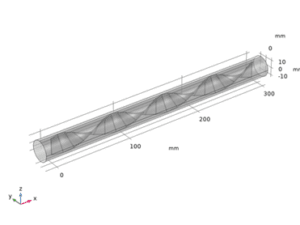
Boundary Conditions
To ensure accurate analysis, the following boundary conditions were applied:
- Inlet: Fluid enters the pipe at 300 K with an inlet velocity determined by the Reynolds number. This range covers laminar and turbulent flow regimes.
- Outlet: A fixed outlet pressure of zero is applied for fluid exiting the pipe.
- Walls: A constant heat flux of 8000 W/m² is applied to the pipe walls to evaluate heat transfer to the fluid.
Simulation Parameters
The simulation parameters were carefully configured to reflect real-world heat transfer and fluid flow conditions. Key details are as follows:

Meshing
High-quality meshing was a critical aspect of this simulation. The pipe geometry was divided into different sections to enhance precision:
- Pipe walls: Mapped square meshing with a high density of small elements for accuracy.
- Inlet and outlet: Triangular mesh elements to accurately model flow variations.
- Twisted tape: Larger mesh elements tailored to the tape’s complex geometry.
An optimized mesh size of 2.17 mm was selected to balance computational cost and accuracy.
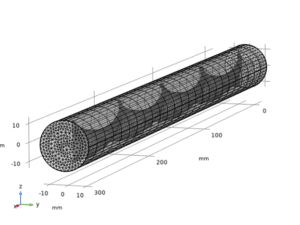
Governing Equations
The following fundamental equations were used in the simulation:
- Navier-Stokes equations: To analyze fluid flow behavior.
- Heat transfer equations: To study temperature variations in the fluid and pipe walls.
- Turbulence models: For turbulent flow regimes, appropriate turbulence models were applied to capture accurate fluid dynamics.
Results and Analysis
Mesh Independence Study
A critical step in the simulation was to ensure results were independent of mesh size. For a mesh size of 2.17 mm, temperature differences within the pipe stabilized, with less than 1% variation, confirming the reliability of the selected mesh size.

Heat Transfer and Nusselt Number
The study revealed that the addition of twisted tape significantly enhanced the heat transfer coefficient and Nusselt number. This improvement was attributed to the vortex flows generated by the tape, which increased fluid mixing. The data also showed a direct correlation between the Reynolds number and the Nusselt number, with twisted tape nearly doubling the Nusselt number at a Reynolds number of 2300 compared to a plain pipe.

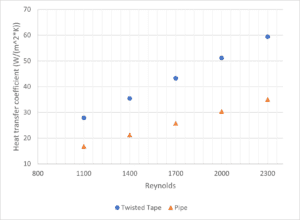
Pressure Drop
The inclusion of twisted tape resulted in a noticeable pressure drop due to increased flow resistance. While this may increase energy consumption, the overall improvement in heat transfer efficiency often justifies the cost in industrial applications.
Temperature Profile
Temperature profile analysis highlighted more uniform temperature distribution along the pipe in the presence of twisted tape. Reduced wall temperature differences and higher fluid outlet temperatures demonstrated better heat absorption and enhanced thermal performance.
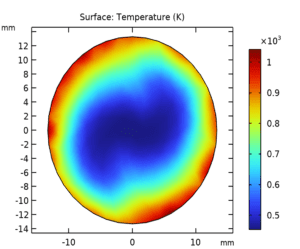
Conclusion
This project demonstrates that twisted tape inserts effectively improve heat transfer and fluid flow characteristics in pipes. Key findings include:
- Significant enhancement in the Nusselt number and heat transfer coefficient due to increased fluid mixing and vortex formation.
- Higher pressure drops, requiring careful design and energy cost considerations.
- Uniform temperature profiles and improved heat absorption capabilities.
These results indicate that twisted tape inserts can play a vital role in improving the efficiency of industrial heat exchangers, particularly in applications requiring precise thermal control.
References Used for This Project:
- Tusar, Mehedi, et al. “CFD study of heat transfer enhancement and fluid flow characteristics of laminar flow through tube with helical screw tape insert.” Energy Procedia 160 (2019): 699-706.
- Eiamsa-ard, Smith, and Pongjet Promvonge. “Enhancement of heat transfer in a tube with regularly-spaced helical tape swirl generators.” Solar energy 78.4 (2005): 483-494.
CFD Simulation for Heat Transfer Enhancement and Fluid Flow in a Pipe with Twisted Tape Inserts
The objective of this project is to investigate the effects of twisted tape inserts on heat transfer and fluid flow characteristics in pipes using Computational Fluid Dynamics (CFD) methods. By simulating fluid flow and heat transfer in the presence of twisted tapes, this study examines the impact of this technique on key parameters such as the Nusselt number and pressure drop.

